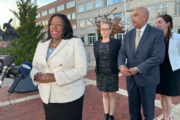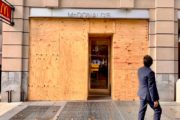Applying to colleges individually can be a time-consuming and costly endeavor. But a solution exists that allows students interested in historically Black colleges and universities to apply to dozens of schools with a single click.
That solution is the Common Black College Application, created in 2000 by Robert Mason to streamline the application process at HBCUs. Students currently can instantly apply to 64 different HBCUs, paying one $20 application fee. Unlike the similarly named Common App, which is used by hundreds of colleges, the CBCA is exclusive to HBCUs. It also offers users a more stripped down application process.
“It’s a pretty straightforward process and only takes about 10 minutes to complete the app,” Mason says.
A graduate of two HBCUs — Virginia State University and Clark Atlanta University — and a former college admissions officer, Mason says the ease of use is a key feature of the Common Black College Application. The application portal requests basic demographic details and family information, a high school transcript, a list of any extracurricular activities, general enrollment plans and college preferences.
Though not required for the portal, students can also upload ACT and SAT scores. Applicants must also answer two questions on disciplinary and criminal history.
“It provides us with all of the supporting documents that we need to admit students to our university,” says Joseph Montgomery, vice president of enrollment management and student success at Tuskegee University in Alabama.
How the Common Black College Application Works
The starting point for prospective students using the Common Black College Application is creating an account and filling out the general details requested. While students can instantly apply to all CBCA member institutions, there is also an option to select their top four enrollment preferences, which colleges can see on the back end.
[Read: A Guide to HBCUs.]
“When we go into the portal, we’re able to see the applications and we’re able to pull them down directly into our system. And once it’s in our system, that student becomes an applicant,” says Lorri L. Saddler, vice president of engagement and alumni relations at Clark Atlanta, where she previously worked as dean of undergraduate admissions.
One key feature of the application that Saddler appreciates is the mobile adaptability. Having a portal that is easily accessible from a mobile device is crucial considering that 95% of American teenagers ages 13 to 17 have access to a smartphone, according to a Pew Research study from 2019. Likewise, a 2019 report from Common Sense Media found that teens in the U.S. spend more than seven hours a day online, not counting time dedicated to school and homework.
“If we can’t meet a student in the palm of their hand, we’re going to miss them,” Saddler says.
Once a student completes the application and hits submit, his or her information is sent on to member institutions, which can see the top four college picks.
“We take our applicants very seriously if they have listed us as one of the top four,” Montgomery says.
But Tuskegee also establishes communication with prospective students who haven’t listed the school among their top four, he adds. The university reaches out with details on academic programs, student outcomes and financial aid opportunities. Such communications offer applicants more options while potentially landing new students for the college.
How Students Use the Common Black College Application
Chad Johnson, a freshman at Fort Valley State University in Georgia, was unsure where he wanted to go when he applied through the CBCA.
“I wanted to keep my options open,” he says.
Applying to such a broad swath of institutions paid off — literally. Johnson says he was offered more than $1.3 million in scholarships from the colleges he applied to using the app. It’s also how he found his current college, which was not among his top four. Ultimately a tour of Fort Valley State is what sold Johnson — an agricultural economics major from Atlanta — on the southwestern Georgia campus and its tightknit community.
“Take your time doing this application, because it is definitely worth it,” Johnson advises college hopefuls.
[Read: Consider a College With a Focus on Minority Students.]
Nikeycia Hadley of Memphis, Tennessee, a freshman studying vocal music at Miles College in Alabama, had a similar experience with the Common Black College Application. She ended up with more than $1.7 million in scholarship offers and acceptances from 40-plus colleges through the CBCA. The portal also helped her with the college search, introducing her to Miles College, an institution she had never heard of.
“I didn’t know that Miles existed before they sent me an acceptance and a scholarship, and now this is my home for the next four years,” Hadley says.
She says the acceptances started adding up, as did the scholarship offers, once she submitted her application.
“I was surprised, actually,” Hadley says. “I cried about it because it really brought joy to my heart, especially knowing that my parents didn’t have to go broke for me to go to school.”
Hadley’s advice to prospective college students is to start the college application process early and to take all parts of it seriously. Applicants should also reach out to schools they’re interested in, contacting admissions and financial aid offices.
What to Know About Rising Interest in HBCUs
In the early years, Mason remembers applications trickling in, first in the single digits, then in the hundreds. Eventually, as the Common Black College Application went online, those numbers began to tick up. Now business is booming.
“We actually had our best year ever” in 2020, Mason says. “We saw a 30% increase in the number of applications.”
Mason expects around 35,000 to 40,000 applications to be submitted through the portal this admissions cycle.
HBCUs also have good news to report on that front, with Saddler pointing to a record number of applications flooding Clark Atlanta. At Tuskegee University, Montgomery reports a stronger yield rate than he’s seen in past admissions cycles, meaning a higher percentage of accepted students ultimately enrolling at the college.
[Read: How Recent Events Reshaped College Admissions.]
For HBCUs, this is perhaps the most visible moment in recent history since the mid-1980s through the early 1990s, when “The Cosby Show” and a subsequent spinoff regularly spotlighted such institutions in front of a national audience. The now-disgraced namesake star, Bill Cosby, frequently donned HBCU sweatshirts on the top-rated show and donated millions to HBCUs. The reach of both that show and “A Different World,” which was set on the campus of a fictitious HBCU, was credited with not only bringing HBCUs more attention, but also with driving increased enrollment at many of those schools.
The public profile of HBCUs seems to be on the rise again due to a variety of factors, experts note. Media coverage of rising applications at HBCUs has focused on reasons such as racial tensions in a social climate where some predominantly white institutions have repeatedly bungled diversity issues; the impact of the Black Lives Matter movement and related protests; major philanthropic donations; positive HBCU responses to dealing with the coronavirus; and the visibility of prominent HBCU alumni, such as Vice President Kamala Harris, who graduated from Howard University in Washington, D.C.
Saddler — who was Harris’ sorority sister at Howard — says this moment for HBCUs has been long overdue.
“Historically Black colleges and universities are now getting the respect and recognition they so richly deserve,” she says. “These institutions were founded with the mission of educating the formerly enslaved and have consistently produced trailblazers and difference-makers. These institutions were designed to produce talent that would go out and change the world, and we have been doing that consistently.”
Searching for a college? Get our complete rankings of Best Colleges.
More from U.S. News
How to Apply to College for Free
See the Most Diverse National Universities
Colleges Requiring a Coronavirus Vaccine for Fall: What to Know
What to Know About the Common Black College Application originally appeared on usnews.com







